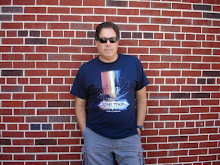
(August 1973, U.S.)
Before I get into this, I invite you all to take a trip back in time with me; to a time when director George Lucas was still a young, original, visionary filmmaker and NOT the man who has (in my opinion) become so overly-corrupted by his own STAR WARS empire, it's sickening! Well, give it a try, anyway...
I was in high school during the mid 1980's, which means I was partially raised by the films of John Hughes and the "Generation X" youth culture they represented. I was also raised by a father who worshipped (and still does!) the golden age of Doo-Wop music, so I wasn't too unfamiliar with its place in music history. Despite the former and, perhaps, partially due to the latter, AMERICAN GRAFFITI remains my favorite film about the coming-of-age of youth.
The film takes place over the course of just about 12 hours. It's the summer of 1962; before the Beatles invade America, before JFK is assassinated, before the Vietnam invasion and before America's innocence is lost forever and all Hell breaks loose all over the country. Cruising in your hot rod, burgers at Mel's Drive-In, high school sock hops and AM rock 'n' roll radio are all the rage of the era - basically, it's a great time to be young! For Ron Howard's and Richard Dreyfuss' characters, Steve and Curt, it's also the last night in their old California town before they head east the next morning to begin their college life. It's a time for saying goodbye and starting over, yes, but as the film progresses, it raises some questions - do we need to be in such a hurry to start a new life simply to conform to society's demands? Do we need to leave a place we've called home for 18 years and the friends we love just to find a new home and new friends?
The rock 'n' roll music of the era serves not just as a background score here, but really, as another character; even the star of the film itself. The kids we see are defined by their love of rock 'n' roll and how it not only takes them on the journey of this night, but also how it has raised them up until now. During the last sequence of the film, there is an unforgettable shot of Curt sitting on the plane that is taking him eastbound. He looks nervous and tense about his new beginning, but there is some comfort in the portable radio he has on his lap, playing The Spaniels "Goodnight Sweetheart Goodnight". It's a little bit of his former youth that he takes with him as his plane soars higher and highter toward his future and his inevitable manhood.
As much as I loved THE STING, AMERICAN GRAFFITTI is the film I thought should have won the Oscar for best picture of 1973.
Favorite line or dialogue:
Terry Fields: "Let me have a Three Musketeers, and a ball point pen, and one of those combs there, a pint of Old Harper, a couple of flash light batteries and some beef jerky."
Barman: "Okay, you got an I.D. for the liquor?"
Terry: "Umm, yeah. Oh, nuts, I left it in the car."
Barman: "Sorry. You'll have to get it before."
Terry: "Well, I...I also...I forgot the car."


No comments:
Post a Comment